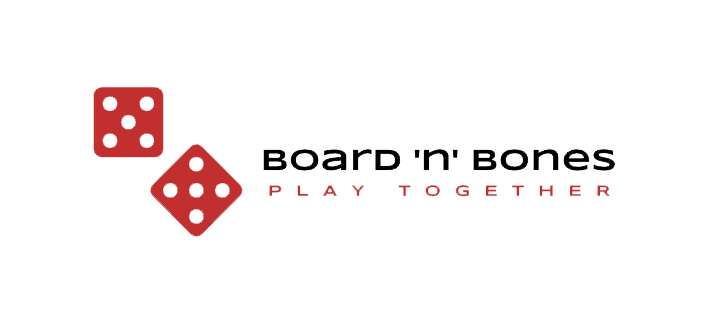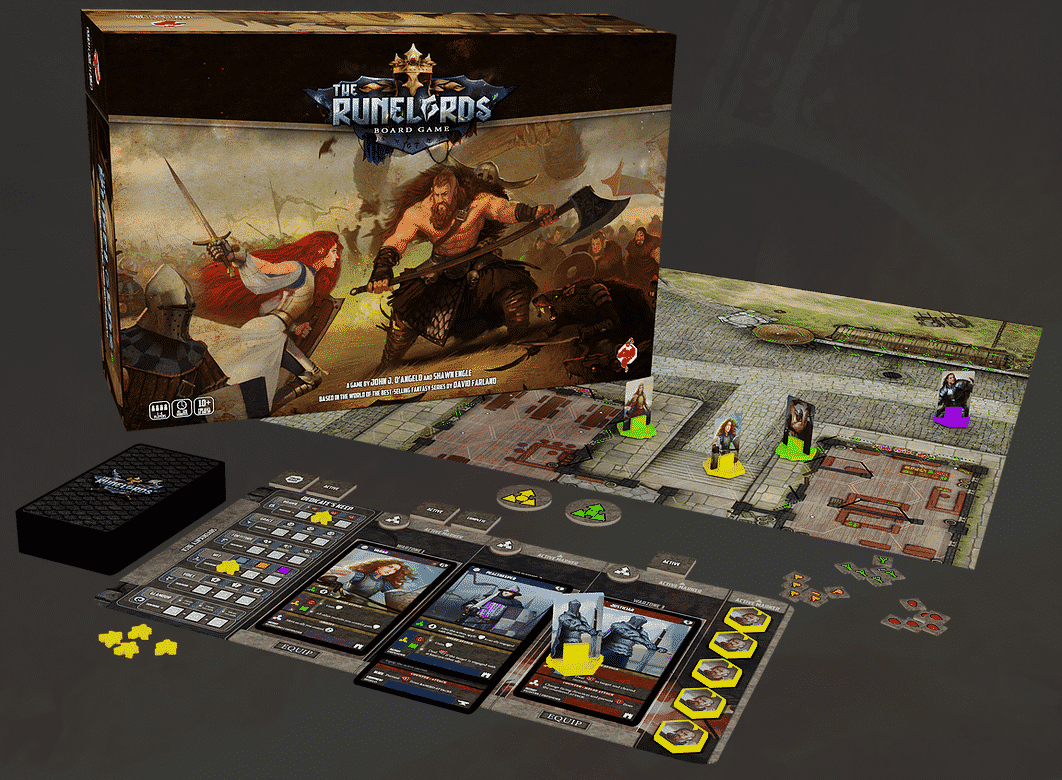Table of Contents




At its core, The Runelords is a card-driven, hex-based skirmish game. Players deploy recruits into battle, then spend their available action points during each activation. Trigger powerful attacks and abilities from either a deployed recruit itself or from the cards in their hand.
To begin play, each player chooses a runelord then everyone chooses one of several game modes. Follow the setup and win conditions found in the Battle Compendium and hit the battlefield!
QUICK OVERVIEW
Let’s have a look at some gameplay basics:
ACTIONS
There are several types of actions that recruits can take during play. All actions will have a cost associated with them and every recruit has access to three action points to spend per activation. If you see an action point icon, simply pay the corresponding point and perform the action shown.
The Runelords Battle Dice
There are 5 battle dice in the game, each tiered by color. The higher the tier, the more powerful the dice.

The combat system is progressive. The better you roll on the battle dice, the more wounds are dealt and the more varied the attack’s effects will be. In the example below, watch how this melee attack gets better as the rolled dice tier increases!

TAKING ENDOWMENTS

During each warzone activation, players have three options when using Facilitators:

Option 1: If activating a warzone with a runelord deployed, simply discard any number of Facilitators from your hand during the Endow Phase and increase any rune of your choice by one for each Facilitator discarded in this way.
Option 2: When activating a warzone with a non-runelord recruit deployed, you may discard a single Facilitator during the Endow Phase and destroy the deployed recruit to increase any rune of your choice by one. If you have another recruit in your hand to deploy, do so, and keep fighting!
Option 3: During the Active Phase of any recruit you control, you may discard any number of Facilitators from your hand and draw a card for each Facilitator discarded in this way.
RECAP: Unique Aspects
- Recruit Actions: When you draw into a recruit, if you do not need or want that recruit to be deployed into battle, you can spend them from your hand for their actions just like any other card! Does that Peacekeeper need a ranged attack this turn? Play your Hound Master for her attack action and discard it. This not only creates surprise attacks that your opponents don’t see coming, but it is also a great way to free up hand space if you need to draw cards and you are at your max hand size.
- Endowments: Runes allow players to level up mid-combat! Do you need that one extra hex of movement? Good thing you drew that Facilitator. Unlock an endowment of Grace and get there!
- Modular Map Tiles: Do you want to play a small, single-tile battlefield where there’s nowhere to run? Select one of six double-sided tiles small enough to bring the battle to a coffee table. Want to play a full-on war with four players? Put all six map tiles together for a 19×27″ double-sided battlefield! [Spoiler: If we are fortunate enough to unlock our second set of double-sided map tiles, they are designed to combine with the core tiles offering two more 38×54″ battlefields! Not recommended for coffee tables.]
- Battle Dice: The progressive battle dice system puts all of the important information during combat into one place. Simply roll the attack’s denoted dice and apply the wounds rolled to the target along with any Weak (circle), Strong (triangle), or Critical (star) effects rolled, each effect unique to the attacking recruit!

This guide is a work in progress.
Join the game designers for this quick overview of combat basics:
[NOTE: All components shown are prototypes and can change based on your feedback.]
Think you’re ready to give it a shot? Download our demo on Tabletop Simulator!

Adventures are scenario-based experiences for 1-4 players depending on the selected adventure. Each adventure will have a guide on how to set up the components for play and specific win|lose conditions for players to solve, hindered by the actions taken by AI-driven recruits called villains.


VILLAINS
Villains follow a simple series of behaviors that are unique to each villain in the adventure. When activating a villain, simply follow its list of behaviors in the order shown. When they have completed all of their behaviors, their activation is complete.
Let’s have a look at a villain from the adventure, The Unrighteous King:

At the top, you will note that this Brute has rulesets for both one or two-player experiences. Every villain will have rulesets that scale its difficulty based on the number of players. In this example, all of this villain’s innate actions are listed in the top section while all his behaviors are listed below. When you activate this villain, you would follow its behavior list from behavior 1 through 5 then complete its activation.
For a better look at the contents of an adventure, download the demo rulebook below or give it a shot on Tabletop Simulator! This guide is a work in progress.




The Sovereignty Stage is an optional game mode where players can take the armies of their favorite runelords and mix them into a resource-management, deck-building engine where players take turns purchasing cards over twelve rounds of play. Purchasing is done from three available markets: The Barracks, The Armory, and The Training Grounds. Along the way, journey cards are drawn where dangerous encounters, exciting events, and aggressive PvP cards can dramatically change the outcome of a player’s resources.
PHASES OF A ROUND
DRAW: All players draw and reveal five cards.
JOURNEY: Beginning with the first player, each player draws a single Journey card, then resolves its contents. If the card being drawn has the PvP card back, only that single card is drawn and all players perform its contents together!
PURCHASE: Beginning with the first player, players may purchase a single card from the available markets or they may pass. After each player has passed or purchased, restock the markets and begin again until all players have either passed or can no longer afford to purchase.
DISCARD/RESTOCK: All players discard any remaining cards from their hands and restock all markets.

WHY THE DECK BUILDER?
Though it’s optional, the deck builder mode allows players to create countless new combos by mixing their runelord’s cards with the cards from other runelords’ armies. As new runelords are introduced in future expansion, old runelords will get a new lease on life, expanding the game’s replayability for years to come!
















You may be asking: “What is a runelord?”
Who better to answer that than the creator himself, author David Farland?
Here’s an interview with David Farland and game design John D’Angelo:
Runelords take qualities like strength, intelligence, and beauty from their willing vassals. As runelords do this, they became stronger as their vassals become weak and infirm. But there’s a catch! The Runelord must keep the vassals safe, lest they lose their powers.


ARTICLES and PODCASTS talking about Runelords
Gabe and John go over the value of community feedback.Check out this interview with Board Game Halv!A fun episode where designers John J. D’Angelo (The Runelords) and Dustin Freund (The Ghosts Betwixt) talk the journey of relaunching on Kickstarter.Patrick of Indie Board Game Designers sits with The Runelords game designer, John J. D’Angelo to ask some important questions!



Risks and challenges of Runelords
Although this is the first game officially created by Red Djinn Productions, our individual teammates have created and shipped board game projects before. As such, we’re well aware of the common bottlenecks in Kickstarter fulfillment. We also are well aware of the supply chain impacts of the COVID-19 pandemic. So with this in mind, here’s what we’re going to do to make sure you get your game on-time and in mint condition: We have an active relationship with our manufacturer. We’ve had prototypes created and we can vouch for their quality. As soon as the campaign funds, we’re ready to manufacture the game. That includes stretch goals too – every single additional goal has been vetted so we can confidently fulfill on-time and within our budget. Slow shipping is also a common problem. That’s why we’ve chosen our domestic and international shipping partners very carefully. We’ve scoured online reviews and have contacted some of their current clients to make sure they’re up to the task. Have a concern that you don’t see addressed above? Let us know in the comments and we’ll happily respond. We love this game and want to get it onto as many tables as possible!

